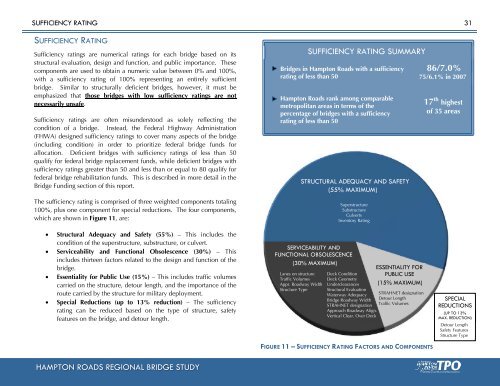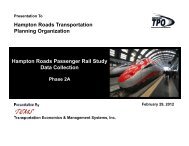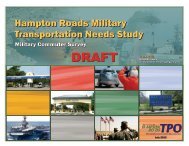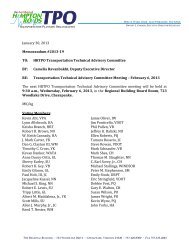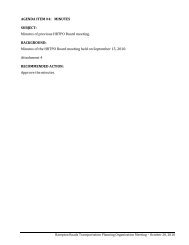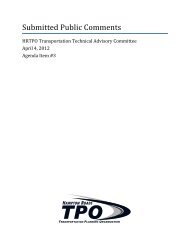Hampton Roads Regional Bridge Study
Hampton Roads Regional Bridge Study
Hampton Roads Regional Bridge Study
Create successful ePaper yourself
Turn your PDF publications into a flip-book with our unique Google optimized e-Paper software.
SUFFICIENCY RATING 31<br />
SUFFICIENCY RATING<br />
Sufficiency ratings are numerical ratings for each bridge based on its<br />
structural evaluation, design and function, and public importance. These<br />
components are used to obtain a numeric value between 0% and 100%,<br />
with a sufficiency rating of 100% representing an entirely sufficient<br />
bridge. Similar to structurally deficient bridges, however, it must be<br />
emphasized that those bridges with low sufficiency ratings are not<br />
necessarily unsafe.<br />
Sufficiency ratings are often misunderstood as solely reflecting the<br />
condition of a bridge. Instead, the Federal Highway Administration<br />
(FHWA) designed sufficiency ratings to cover many aspects of the bridge<br />
(including condition) in order to prioritize federal bridge funds for<br />
allocation. Deficient bridges with sufficiency ratings of less than 50<br />
qualify for federal bridge replacement funds, while deficient bridges with<br />
sufficiency ratings greater than 50 and less than or equal to 80 qualify for<br />
federal bridge rehabilitation funds. This is described in more detail in the<br />
<strong>Bridge</strong> Funding section of this report.<br />
The sufficiency rating is comprised of three weighted components totaling<br />
100%, plus one component for special reductions. The four components,<br />
which are shown in Figure 11, are:<br />
SUFFICIENCY RATING SUMMARY<br />
<strong>Bridge</strong>s in <strong>Hampton</strong> <strong>Roads</strong> with a sufficiency<br />
rating of less than 50<br />
<strong>Hampton</strong> <strong>Roads</strong> rank among comparable<br />
metropolitan areas in terms of the<br />
percentage of bridges with a sufficiency<br />
rating of less than 50<br />
STRUCTURAL ADEQUACY AND SAFETY<br />
(55% MAXIMUM)<br />
Superstructure<br />
Substructure<br />
Culverts<br />
Inventory Rating<br />
86/7.0%<br />
75/6.1% in 2007<br />
17 th highest<br />
of 35 areas<br />
<br />
<br />
<br />
<br />
Structural Adequacy and Safety (55%) – This includes the<br />
condition of the superstructure, substructure, or culvert.<br />
Serviceability and Functional Obsolescence (30%) – This<br />
includes thirteen factors related to the design and function of the<br />
bridge.<br />
Essentiality for Public Use (15%) – This includes traffic volumes<br />
carried on the structure, detour length, and the importance of the<br />
route carried by the structure for military deployment.<br />
Special Reductions (up to 13% reduction) – The sufficiency<br />
rating can be reduced based on the type of structure, safety<br />
features on the bridge, and detour length.<br />
SERVICEABILITY AND<br />
FUNCTIONAL OBSOLESCENCE<br />
(30% MAXIMUM)<br />
Lanes on structure<br />
Traffic Volumes<br />
Appr. Roadway Width<br />
Structure Type<br />
Deck Condition<br />
Deck Geometry<br />
Underclearances<br />
Structural Evaluation<br />
Waterway Adequacy<br />
<strong>Bridge</strong> Roadway Width<br />
STRAHNET designation<br />
Approach Roadway Align.<br />
Vertical Clear. Over Deck<br />
ESSENTIALITY FOR<br />
PUBLIC USE<br />
(15% MAXIMUM)<br />
STRAHNET designation<br />
Detour Length<br />
Traffic Volumes<br />
SPECIAL<br />
REDUCTIONS<br />
(UP TO 13%<br />
MAX. REDUCTION)<br />
Detour Length<br />
Safety Features<br />
Structure Type<br />
FIGURE 11 – SUFFICIENCY RATING FACTORS AND COMPONENTS<br />
HAMPTON James City/Williamsburg/York ROADS REGIONAL Transportation BRIDGE STUDY <strong>Study</strong>


